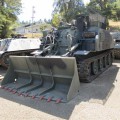
Famo Rubezahl | |
|---|---|
| Страна | Nazi Germnay |
| Роля | Caterpillar tractor |
| Произведени | 1932-1944 |
| Построен | Не знам |
FAMO, short for Fahrzeug- und Motoren-Werke (Automobile and Engine Works) was a German vehicle manufacturer in the early 20th century. The middle crawler tractor Rübezahl was continued under the name FAMO Rübezahl until 1944. With a 65 HP engine it could tow up to 6 tons.
Източник: Famo Rubezahl on Wikipedia
| Famo Rubezahl Walk Around | |
|---|---|
| Фотограф | Юрий Пахолок |
| Локализация | Lehn Collection, Oldtimer Gallery |
| Снимки | 125 |
Комплекти свързани:
Намерете комплекти в иБей:
Famo Rubezahl is a legendary figure from the folklore of the Silesian and Bohemian mountains. He is said to be a powerful spirit who can control the weather, shape-shift into various forms, and perform magic. He is also known for his trickery and mischief, often playing pranks on humans or testing their morality. Some stories depict him as a benevolent protector of the poor and the oppressed, while others portray him as a cruel and vengeful tyrant.
Famo Rubezahl’s name derives from the German word “Rübezahl”, which means “turnip counter”. According to one legend, he was once so annoyed by a farmer who had stolen some of his turnips that he cursed him to count them endlessly. Another version says that he was given this name by a monk who wanted to mock his vanity and ignorance. Famo Rubezahl’s origins are shrouded in mystery, but some scholars suggest that he may have been inspired by ancient Slavic deities or Celtic druids. He is often associated with the Krkonoše Mountains (also known as the Giant Mountains or Riesengebirge), where he is said to dwell in a hidden palace. Famo Rubezahl has been featured in many literary works, such as the fairy tales of Johann Karl August Musäus and the poems of Joseph von Eichendorff. He has also influenced the art and culture of the regions where he is revered, appearing in paintings, sculptures, songs, and festivals.
Views : 2146









